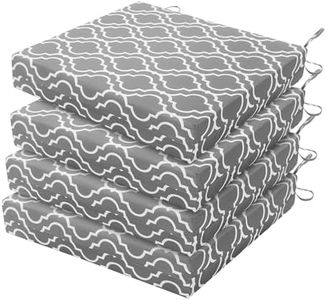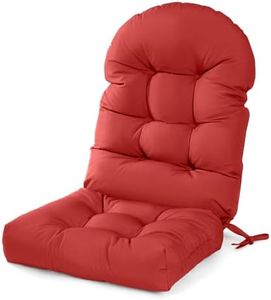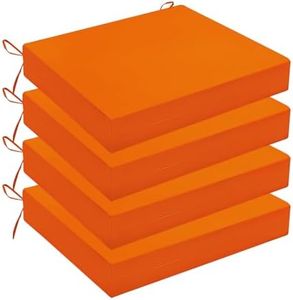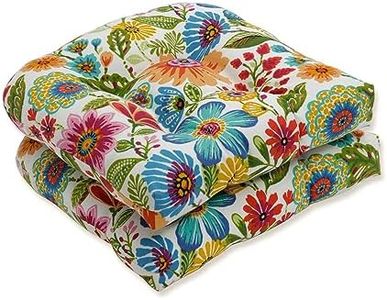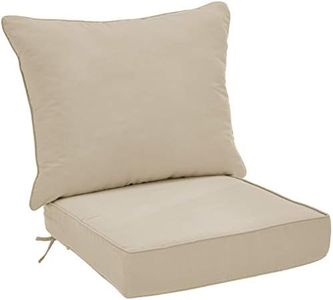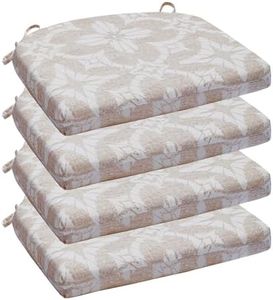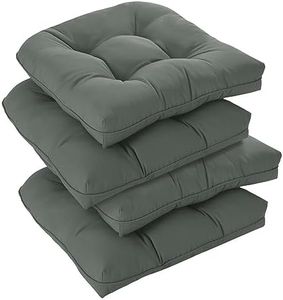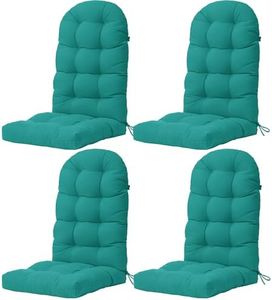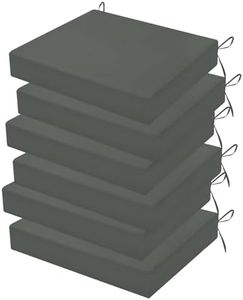We Use CookiesWe use cookies to enhance the security, performance,
functionality and for analytical and promotional activities. By continuing to browse this site you
are agreeing to our privacy policy
10 Best Patio Chair Cushions
From leading brands and best sellers available on the web.Buying Guide for the Best Patio Chair Cushions
Choosing the right patio chair cushions can greatly improve your outdoor seating comfort while also enhancing the style of your space. It's not just about picking a color you like; you also need to consider factors like comfort, durability, size, and ease of care. By focusing on key features, you can select cushions that look good, last long, and feel great every time you use your outdoor chairs.MaterialThe material of a cushion refers to both the fabric covering and the inner filling. This is important because it affects comfort, weather resistance, and how easy it is to clean the cushions. Common fabrics include polyester, acrylic, and olefin, each with strengths like UV resistance or softness. Polyester is generally affordable and dries quickly, acrylic often resists fading and mildew, and olefin is strong against weather and stains. When choosing, think about your climate: if your patio is exposed to lots of sun or rain, it's best to select weather-resistant, fade-resistant fabrics; if cushions will mostly stay under cover, you might prioritize softness and feel instead.
Cushion ThicknessCushion thickness determines how soft and supportive your seating will feel. Thinner cushions (about 1-2 inches) might be suitable for occasional use or decorative purposes, while medium thickness (3-4 inches) offers a good balance for regular relaxation. Thicker cushions (5 inches or more) give plush support, great for lounging for long periods. Your choice should be based on how long you typically sit outside: those who enjoy lengthy outdoor meals or lounging should go thicker, while for short coffee breaks, thinner options may suffice.
Size and ShapeCushions come in different lengths, widths, and shapes to fit a variety of chair styles, such as dining chairs, loungers, or benches. Getting the right fit is important for comfort, appearance, and stability—the cushion shouldn’t be too small to slide around or too large to bunch up awkwardly. Measure your chair’s seat and back before shopping, and consider the shape (rectangle, square, contoured, etc.) that matches your furniture. Pick cushions that closely fit your chair’s dimensions for the best results.
Attachment MethodThe way cushions attach to your chairs matters for ease of use and safety, especially in windy areas. Some cushions have tie-on straps, buttons, or hook-and-loop fasteners. Straps or ties are good for keeping cushions in place, especially if kids or pets are around or if your area is breezy. If you want cushions that are easy to remove for cleaning or storage, look for ones with simple or detachable fastenings.
Weather ResistanceWeather resistance means how well a cushion stands up to sun, rain, and humidity. A good outdoor cushion should resist fading, moisture, and mildew. Water-resistant or quick-dry cushions are essential if your furniture isn’t under a roof. If you expect lots of sun, look for fade-resistant labels. Those in rainy or humid climates should focus on mildew resistance. Pick cushions based on your local weather: the harsher your climate, the more weather resistance you’ll need.
Ease of CleaningSince patio furniture is exposed to outdoor elements, spills, and dirt, ease of cleaning is key. Some cushions have removable covers that can be machine washed, while others need spot cleaning. If you have kids, pets, or entertain often, removable, washable covers can save a lot of effort. If cleaning often isn’t an option, look for stain-resistant fabrics to keep cushions looking fresh with minimal effort.
Style and ColorThis is about how the cushions look and how they fit in with your outdoor decor. Some patterns and colors are better at hiding stains or fading; darker colors and busy patterns can hide spills, while lighter, bright colors may need more frequent cleaning. Choose a style that matches your overall patio look—whether you want something bold to add personality or neutral tones for a calm setting, your taste and the look of your space should be your guide.
